Kashmir conflict: The dispute unresolved (Part 1)
The article will become very lengthy one but I will put only the main parts of history that have taken place in history of this dispute so I will be writing it in parts.
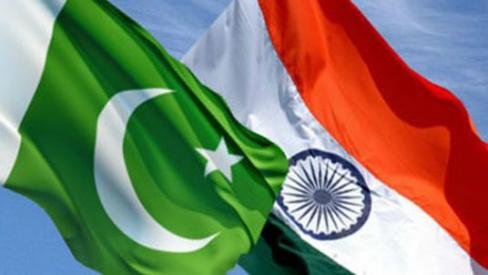
Image source: pochta-polevaya.ru
The Kashmir dispute is a territorial conflict primarily between India and Pakistan started just after the partition of India in 1947 by British. Till now both countries have fought four wars. The conflict of the disputed land of Jammu and Kashmir has been linked to spark nuclear war between two countries. The escalating tensions on the Kashmir border between India and Pakistan have given rise to fears of a major confrontation between the two nuclear powers that could very well draw other nations into the conflict and start World War 3.
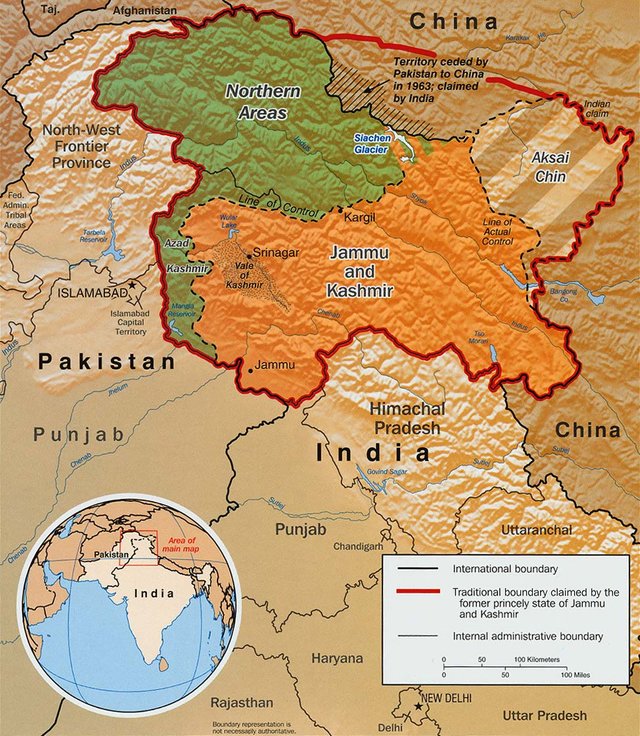
Image source: wikipedia
Background and early history
Jammu and Kashmiris bounded to the northeast by Autonomous Region of Xinjiang (China), to the east by the Tibet Autonomous Region (China) and the Chinese-administered portions of Kashmir, to the south by the Indian states of Himachal Pradesh and Punjab, to the southwest by Pakistan, and to the northwest by the Pakistani-administered portion of Kashmir. The administrative capitals are Srinagar in summer and Jammu in winter. Area 39,146 square miles (101,387 square km). Pop. (2011) 12,541,302.
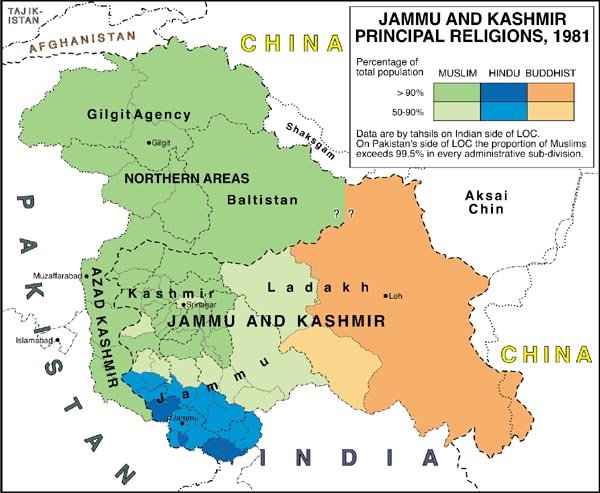
Image source: kashmirstudygroup.com
According to Hindu mythology of 12 th century the Kashmir valley was formerly lake which was formed by cutting a gap in hills at Baramulla. That land came to be known as Kashyapamar and, later, Kashmir.
Time to time the region has been ruled by different kings of different religion thus making it more diverse region in south east continent.
Mauryan emperor Ashoka in the 3rd century BCE introduced Buddhism. From the 9th to the 12th century CE the region had become the prominent for Hindu religion. A succession of Hindu dynasties ruled Kashmir until 1346, when it came under Muslim rule. The Muslim period lasted nearly five centuries which was ended by the Sikh emperor when Maharaja Ranjit Singh annexed Kashmir in 1819 and then British in 1846, by the treaties of Lahore and Amritsar after First Anglo-Sikh war Raja Gulab singh was made ruler of Jammu and Kashmir as a puppet. The creation of this state was made by British to safeguard the Indian British Empire from Communist Russia and China in north.
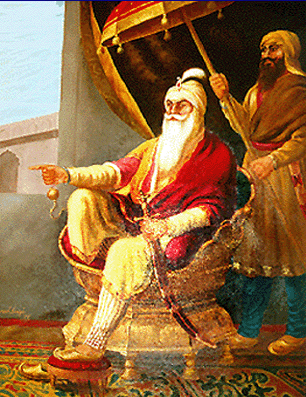
Maharaja Ranjit SinghImage source:sikhlibraryandmuseum.ca
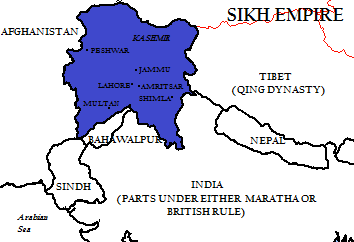
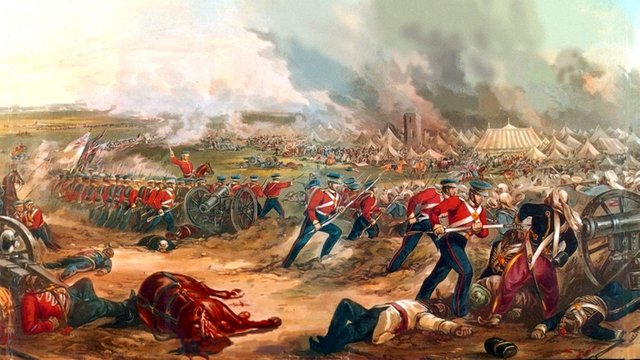
First Anglo-Sikh war 1867Image source dharmatoday.com
There were some attempts made in 19th century to demarcate the boundaries. Maharaja Gulab Singh claimed his territory from the Karakoram Range to Turkistan and Xinjiang regions of Central Asia, and the boundary was never demarcated.There were similar doubts about the alignment of the frontier where this northern zone skirted the region known as Aksai Chin, to the east. However British managed to negotiate boundaries of pamirs region and Gilgit was considered as integral part of Kashmir.
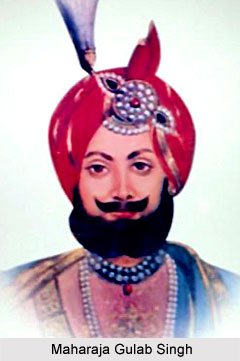
King Gulab Singh of Jammu and KashmirImage source: indianetzone.com
When Gulabsingh took possession of J&K , the state’s population was 77 percent Muslim, 20 % Hindu and 3% others(Sikhs and Buddhists). Despite being Muslim Majority the state was ruled by Hindu ruler.
Partition, Invasion of Kashmir and Accession
With the end of British rule in 1947 2 new states were created Pakistan and India. According to Indian independence act of 1947 562 princely states of India had to decide whether to join India or Pakistan or remain independent. Jammu and Kashmir, the largest princely states under Hindu ruler Hari singh wanted to stay independent. As he thought joining Pakistan will make both Hindus and Sikh minority in Pakistan and Muslim may revolt if he joined India.
Meantime Pakistan made various efforts to plead Maharaja Hari singh to join Pakistan. Pakistan Leader Mohammad ali Jinnah even promised special treatment to him if he join Pakistan. Hari Singh indecision made Pakistan to wage a war against him by obstructing fuel and essential commodities.
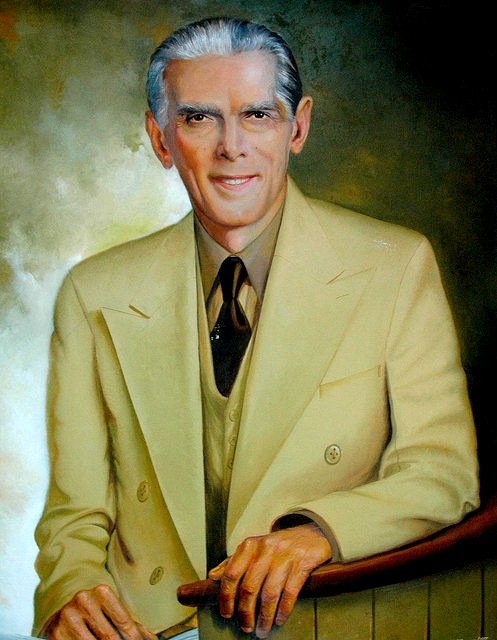
Image source: oneway2day.files.wordpress.com
Muhammad Ali Jinnah
During September and October 1947 there was a mass migration of Muslim from India to Pakistan and Hindus and Sikhs into India from Pakistan. During this time there was mass rioting and killings all over the Punjab after partition which further wide spread into Kashmir. Due to this about 70,000 Muslim were killed and about 400,000 fled to Pakistan from Kashmir. By 22-24 October 1947 the rebel forces got organized to fight against the ruler.
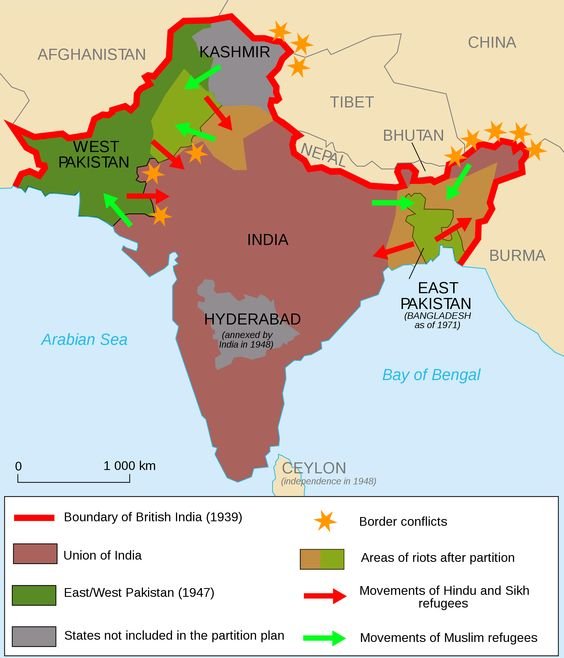
Mass migration of Indian subcontinent during 1947
By September of 1947 Maharaja hari singh sent his delegates to Indian PM Nehru to provide supply of essential commodities for his state and his willingness to accede to India. Nehru demanded release of Sheikh Abdullah and maharaja released him on 29th of September 1947.
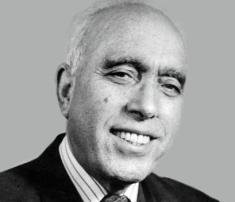
Image source: jandknow.com
Sheikh Mohammed Abdullah
In beginning of October 1947 Pakistan tribal invasion began into Kashmir by Pakistan. Rebel forces from western districts along Pakistan and Pakistani Pakhtoon tribesmen made rapid advances into baramulla sector. This was the starting of First Kashmir war that lasted until end of 1948.
In North of the state lay Gilgit Agency which was muslim majority and did not favour the state’s accession to India. So the whole Gilgit planned coup d'etat and joined war against the maharaja hari singh.
On 1 November 1947, Mountabatten flew Lahore to convince Jinnah about the matter and he told him it was the matter of people of jammu and Kashmir weather to decide they remain independent or join one of the countries when Ruler has not decided. Jinnah rejected all proposals of mountabatten.
According to Jinnah, India acquired the accession through “fraud and violence.” A plebiscite was unnecessary and states should accede according to their majority population. For a plebiscite, Jinnah demanded simultaneous troop withdrawal for he felt that 'the average Muslim would never have the courage to vote for Pakistan' in the presence of Indian troops and with Sheikh Abdullah in power. When Mountbatten countered that the plebiscite could be conducted by the United Nations, Jinnah, hoping that the invasion would succeed and Pakistan might lose a plebiscite, again rejected the proposal, stating that the Governors Generals should conduct it instead. Mountbatten noted that it was untenable given his constitutional position and India did not accept Jinnah’s demand of removing Sheikh Abdullah.
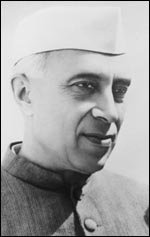
Former Indian Prime minister Jawahar Lal Nehru
By December of 1947 Nehru met PM of Pakistan Liaquat ali kahn. Nehru showed India’s willingness on the matter of dispute to be settled in United Nations under article 35 of the UN charter.
UN mediation in dispute
India wanted to sought out dispute at the UN security council, despite Sheikh Abdullah’s opposition to this matter. UN formed UNCIP(United Nations Commission for India and Pakistan), the UN Security council passed Resolution 47 on 21April 1948. The measures were
Immediate cease-fire and called on the Govt of Pakistan to withdraw its troop from state of jammu and Kashmir and its tribesman that were not resident of the state of jammu and Kashmir and have entered there only for war.
It asked government of India to reduce its force to minimum strength to hold plebiscite in state
It was a two part process in first it asked Pakistan to withdraw its forces. In second part India have to withdraw the bulk of its forces . After both have completed the process, a plebiscite would be held. The resolution was accepted by india but rejected by Pakistan.
India itself regarded as a legal possessor of Jammu and Kashmir through instrument of accession and regarded Pakistan as a aggressor. However both parties never came to conclusion and never the process of demilitarization was done till date.
http://www.un.org/en/ga/search/view_doc.asp?symbol=S/RES/51(1948)
UN Security council resolution 1948
References
1.http://www.jammu-kashmir.com/documents/instrument_of_accession.html
2.http://www.centralexcisehyderabad4.gov.in/documents/history/1947_2.PDF
3.https://web.archive.org/web/20121020184914/http://www.1911encyclopedia.org/Kashmir
4.https://books.google.co.in/books?id=ZzEAFgW8TYwC&pg=PA36&redir_esc=y#v=onepage&q&f=false
5.http://eprints.soton.ac.uk/366712/1.hasCoversheetVersion/Ilyas%20PhD-E-Thesis.pdf
6.https://books.google.co.in/books?id=hQ8p4XTRZgEC&pg=PT48&redir_esc=y#v=onepage&q&f=false
7.http://edition.cnn.com/2002/WORLD/asiapcf/east/05/24/aksai.chin/
8.https://books.google.co.in/books?id=SiYUDAAAQBAJ&pg=PA340&redir_esc=y#v=onepage&q&f=false
9.http://news.bbc.co.uk/2/hi/in_depth/south_asia/2002/kashmir_flashpoint/default.stm
10.https://en.wikipedia.org/wiki/Kashmir_conflict
11.https://www.britannica.com/place/Kashmir-region-Indian-subcontinent
This post has been ranked within the top 80 most undervalued posts in the first half of Feb 14. We estimate that this post is undervalued by $4.61 as compared to a scenario in which every voter had an equal say.
See the full rankings and details in The Daily Tribune: Feb 14 - Part I. You can also read about some of our methodology, data analysis and technical details in our initial post.
If you are the author and would prefer not to receive these comments, simply reply "Stop" to this comment.
Thanks